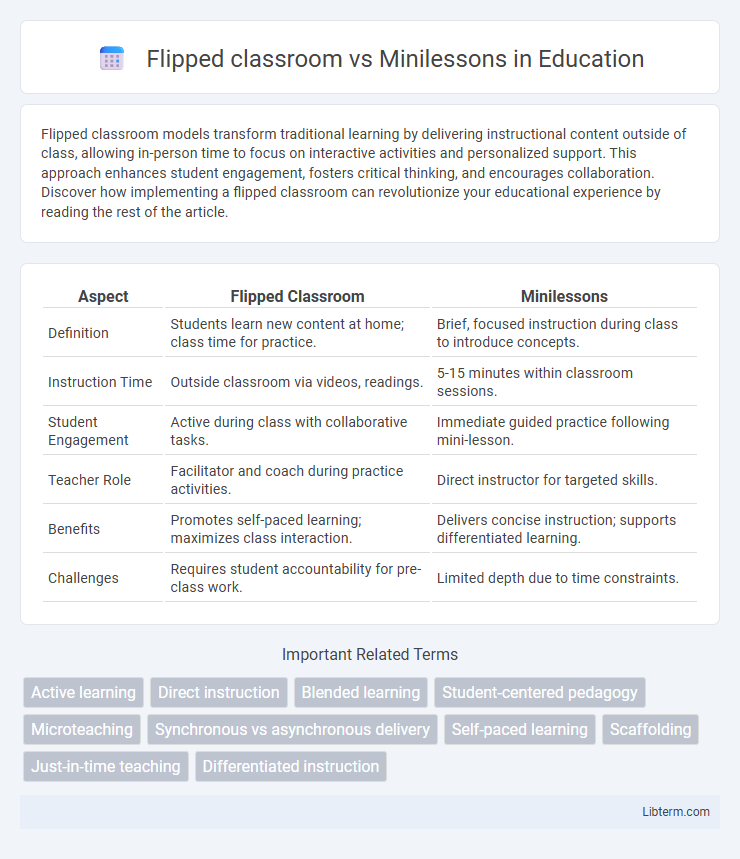Flipped classroom models transform traditional learning by delivering instructional content outside of class, allowing in-person time to focus on interactive activities and personalized support. This approach enhances student engagement, fosters critical thinking, and encourages collaboration. Discover how implementing a flipped classroom can revolutionize your educational experience by reading the rest of the article.
Table of Comparison
| Aspect | Flipped Classroom | Minilessons |
|---|---|---|
| Definition | Students learn new content at home; class time for practice. | Brief, focused instruction during class to introduce concepts. |
| Instruction Time | Outside classroom via videos, readings. | 5-15 minutes within classroom sessions. |
| Student Engagement | Active during class with collaborative tasks. | Immediate guided practice following mini-lesson. |
| Teacher Role | Facilitator and coach during practice activities. | Direct instructor for targeted skills. |
| Benefits | Promotes self-paced learning; maximizes class interaction. | Delivers concise instruction; supports differentiated learning. |
| Challenges | Requires student accountability for pre-class work. | Limited depth due to time constraints. |
Introduction to Flipped Classroom and Minilessons
The flipped classroom model reverses traditional teaching by delivering instructional content, often online, outside of class, allowing in-person time for interactive, application-based activities. Minilessons are brief, focused teaching segments designed to target specific skills or concepts, typically delivered during class to scaffold student learning. Both approaches aim to enhance student engagement and understanding, with the flipped classroom emphasizing pre-class preparation and minilessons focusing on concise, targeted instruction during class time.
Core Principles of Each Approach
The flipped classroom model centers on pre-class content consumption, empowering students to engage actively during in-class time through collaborative exercises and personalized support. Minilessons emphasize concise, targeted instruction delivered directly before practice sessions, fostering immediate application and skill reinforcement. Both approaches prioritize student-centered learning but differ in timing and delivery to optimize engagement and comprehension.
Instructional Design Differences
Flipped classroom instruction involves students engaging with video lectures or digital content at home, freeing classroom time for interactive activities and personalized support, while minilessons consist of brief, focused direct instruction sessions within the classroom to introduce specific skills or concepts. Instructional design for flipped classrooms prioritizes creating rich multimedia content and integrating technology for independent learning, whereas minilessons emphasize concise, targeted teaching embedded in daily lessons to scaffold student understanding. The flipped model requires advanced planning of asynchronous materials, whereas minilessons rely on real-time assessment and adaptation to student needs during instruction.
Student Engagement and Participation
Flipped classrooms enhance student engagement by allowing learners to interact with content at their own pace before class, freeing up in-person time for active discussions and collaborative problem-solving. Minilessons, typically brief and targeted, focus on direct instruction and immediate practice, which can boost participation through concentrated and focused activities. Both approaches foster student involvement, but flipped classrooms often lead to deeper engagement through student-driven exploration and peer interaction.
Role of Technology in Both Models
The flipped classroom leverages technology by providing students with video lectures and digital resources for pre-class learning, enabling in-class time for interactive activities and personalized instruction. In minilessons, technology supports brief, focused teaching segments through multimedia presentations and real-time feedback tools, enhancing student engagement and comprehension. Both models utilize digital platforms to facilitate differentiated learning and immediate assessment, optimizing instructional efficiency and student outcomes.
Time Management for Teachers and Students
Flipped classroom models optimize time management by allowing students to engage with lectures at their own pace outside class, freeing in-class time for interactive activities and personalized support. Minilessons provide concise, targeted instruction during class, enabling teachers to efficiently address specific skills while maximizing students' focus and retention within limited periods. Both approaches enhance time utilization, but flipped classrooms emphasize self-paced learning, whereas minilessons prioritize direct, time-bound teaching moments.
Assessment and Feedback Methods
Flipped classrooms leverage pre-class video content to maximize in-class time for interactive assessments, enabling real-time formative feedback through quizzes and peer discussions. Minilessons incorporate brief, targeted instruction followed by immediate assessment tasks that allow teachers to provide specific, actionable feedback promptly. Both methods prioritize ongoing evaluation but differ in timing and delivery, with flipped classrooms shifting initial content absorption outside class and minilessons emphasizing concise, teacher-led assessment during instruction.
Impact on Learning Outcomes
Flipped classrooms foster active learning by allowing students to engage with instructional content outside of class, leading to improved comprehension and higher retention rates. Minilessons, characterized by focused, time-efficient teaching segments, enhance skill acquisition and provide immediate feedback, which accelerates mastery of concepts. Comparing both, flipped classrooms tend to show greater long-term impact on critical thinking and independent learning, while minilessons effectively boost short-term performance and classroom engagement.
Challenges and Limitations
Flipped classrooms often face challenges such as unequal access to technology, leading to disparities in student preparedness and engagement. Minilessons, while allowing for focused instruction, can be limited by time constraints that restrict depth and student interaction. Both approaches require significant teacher preparation and adaptability to meet diverse learner needs effectively.
Choosing the Right Model for Your Classroom
Selecting the right instructional model depends on student needs and learning objectives, with flipped classrooms providing extensive pre-class content delivery to maximize interactive class time. Minilessons offer targeted, concise instruction within the classroom, allowing immediate feedback and reinforcement. Evaluating factors such as student independence, technology access, and curriculum complexity helps determine which approach best enhances engagement and comprehension.
Flipped classroom Infographic

 libterm.com
libterm.com